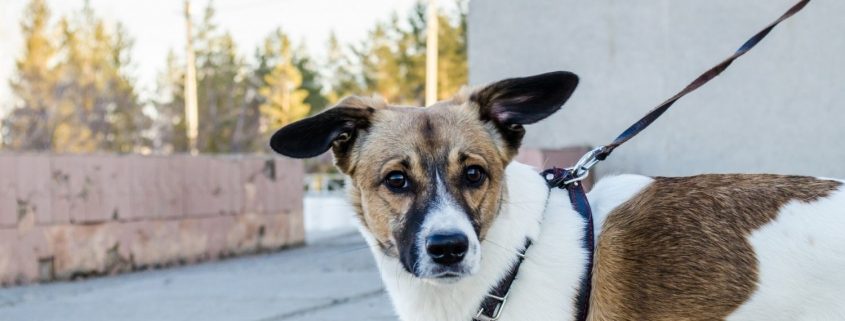Ask Crystal: Leash Walking Training Tips
Welcome to “Ask Crystal,” where you can ask your pet behavior questions! You can submit your question for Crystal at the bottom of the page!
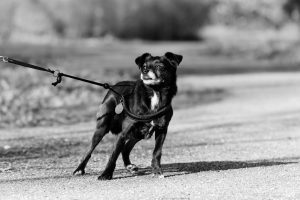 Dear Crystal,
Dear Crystal,
We adopted a new dog recently and we need some advice. We walk her around constantly outside and she is taken for a serious walk daily too. She pulls on the leash like a monster. It is getting some better. I have learned that unless you get her attention you are not going to see any change. I tried all the treats and stopping until she was doing it like I wanted but I was just never able to reward her for good stuff as it never happened.
Sincerely,
Leash Monster
Dear Leash,
You are not alone in this complaint. Pulling on leash is one of the most common complaints that owners have about their dogs. Dogs pull on leash for a lot of reasons but the good news is that with patience and training you can get a dog that enjoys walking by your side. I love walking with a dog that is checking in with me frequently and not dragging me around. There is a connection there that makes walks a bonding experience that is so much more enjoyable.
It’s important to understand the reasons why dogs pull. Dogs move in a variety of ways such as trotting, running, and galloping. They rarely walk and walking is the primary way that we humans move. We just move a lot slower than they do. There is also a lack of training and consistency with most owners. If you let your dog pull sometimes, that type of reinforcement is very strong. We get in a hurry and let them pull occasionally and that makes it really hard to get rid of the behavior. Some dogs never learn to walk on a loose leash because the owner never gives them any slack. Maybe the dog is walked on an ever taunt flexi-lead or the owner constantly walks with the dog on a tight short leash.
Controlling your dog with the leash is does not teach anything. The leash is an emergency brake not a steering wheel. Sometimes you need to control the dog’s location but just understand that you are managing the dog, not teaching them. In order for the dog to learn, it needs to be moving into position of its own accord. If you know that you have a tendency to pull up on the leash, you can start training these techniques inside off leash to start with. They also make leashes that hook to a waist belt so that you aren’t pulling on the leash with your hands at all.
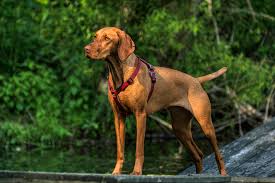 I suggest that you purchase a front connection harness for your dog. These harnesses help owners train by turning the dog’s front end towards the handler. If you can get the dog to turn back it gives slack in the leash which allows for reinforcement for correct behavior. The harness allows a small handler more control over a large pulling dog. It is also easier to use than a head halter which many dogs find averse. There is a lot of talk in the dog training and veterinarian world about concerns with harnesses that restrict a dog’s natural movement. Look for harnesses that allow for full movement of the shoulder. In addition, new information indicates the y-shape straps across the chest are safer for preventing injury. Some harnesses that meet these qualifications are Balance Harness, Ruffwear Front Range Harness and the Perfect Fit Modular Fleece Harness. Visit your local pet store boutique and asked for their expert help in recommending a harness and fitting it.
I suggest that you purchase a front connection harness for your dog. These harnesses help owners train by turning the dog’s front end towards the handler. If you can get the dog to turn back it gives slack in the leash which allows for reinforcement for correct behavior. The harness allows a small handler more control over a large pulling dog. It is also easier to use than a head halter which many dogs find averse. There is a lot of talk in the dog training and veterinarian world about concerns with harnesses that restrict a dog’s natural movement. Look for harnesses that allow for full movement of the shoulder. In addition, new information indicates the y-shape straps across the chest are safer for preventing injury. Some harnesses that meet these qualifications are Balance Harness, Ruffwear Front Range Harness and the Perfect Fit Modular Fleece Harness. Visit your local pet store boutique and asked for their expert help in recommending a harness and fitting it.
Always start by training any new behavior inside the house where there are less distractions. A big mistake people make is trying to train in very distracting environments right away. They don’t have much success and get frustrated. Your job as your dog’s trainer is to figure out how you can help him be successful. Start in low distraction areas so the dog can pay attention and feed high value treats so the dog will be motivated to work. As your dog learns the behavior, you can begin to make the environment a little more challenging by moving to the backyard, driveway, front yard, street in front of the house, etc. Every time you move to a more challenging area, loosen up on your criteria so that you can have something to reinforce.
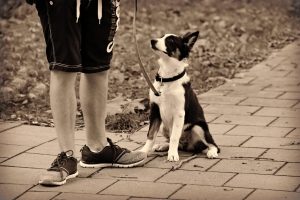 Attention is an important first behavior to work on for leash walking. If you cannot get your dog’s attention you will not be able to train him. Leslie McDevitt’s Pattern Games have fun games to reinforce eye contact such as Up and Down. In this game, you stand in front of the dog and wait for eye contact. When the dog looks at you, say “yes” and drop the treat on the ground. This sets the dog up for another repetition. You can also teach your dog a “Watch” cue but putting a lure up to the dog’s nose and draw a line to your eye with it. When the dog looks at you, mark and treat. Once he knows the cue, you can call him to look at you so that he won’t get overly excited and pull towards something like another dog or squirrel.
Attention is an important first behavior to work on for leash walking. If you cannot get your dog’s attention you will not be able to train him. Leslie McDevitt’s Pattern Games have fun games to reinforce eye contact such as Up and Down. In this game, you stand in front of the dog and wait for eye contact. When the dog looks at you, say “yes” and drop the treat on the ground. This sets the dog up for another repetition. You can also teach your dog a “Watch” cue but putting a lure up to the dog’s nose and draw a line to your eye with it. When the dog looks at you, mark and treat. Once he knows the cue, you can call him to look at you so that he won’t get overly excited and pull towards something like another dog or squirrel.
Start by deciding what side you want to walk your dog on. In dog obedience sports, dogs are traditionally walked on the left but it is really your choice. I would suggest during training that you stick to one side and you can train him to walk on the other side later if needed. Hold the leash in the hand opposite the dog, so that you can use the hand near the dog to treat the dog. This prevents the dog from crossing in front of you to get the treats and allows you to feed where you want the dog to be.
Pick a quiet spot in your house to begin training. Start out by standing right next to your dog and marking the correct position with a mark word of “yes” and then treating the dog right at your pants seam level to their head. We always want to pay the dog where we want them to be. Repeat this several times. Next move slightly out of position and mark as soon as the dog starts to move towards you. Treat at your leg. Repeat until the dog moves into the correct position every time you move out of it. Gradually begin to increase the number of steps in between. The key here is to slowly add in more steps and build up on good, solid behavior. Next work on changing direction and speed. Moving faster will also help keep your dog’s attention. Then you can move on to a more interesting space and start over again at the first step. Every time you move to a more difficult space, start over in the process. The goal is to have a dog that offers to walk by your side without being told to. But it is a good idea to have the behavior on cue for those times when you need to get their attention. You can add a verbal cue by saying, “let’s go” right as your dog is moving into the position by your side.
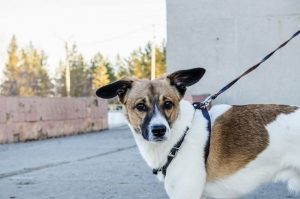 When your dog does pull while on a walk, there are a few different techniques that you can use. The goal of all of these techniques is to avoid reinforcing the pulling by allowing it to continue and to get the dog in a position to have a slack leash so that the walk can keep happening. The dog needs to learn when I pull the walk stops and doesn’t start until there is slack in the leash and will only continue if there is slack. The “I am a Rock” technique means that when your dog pulls, stop and ignore the dog. Wait for the moment that the dog turns back to you, mark and hold the treat by your pants leg. Then start walking. “Back and forth” means that when your dog pulls, turn around and walk in the opposite direction. When the dog catches up to your side, mark and treat and then go back to your original direction.
When your dog does pull while on a walk, there are a few different techniques that you can use. The goal of all of these techniques is to avoid reinforcing the pulling by allowing it to continue and to get the dog in a position to have a slack leash so that the walk can keep happening. The dog needs to learn when I pull the walk stops and doesn’t start until there is slack in the leash and will only continue if there is slack. The “I am a Rock” technique means that when your dog pulls, stop and ignore the dog. Wait for the moment that the dog turns back to you, mark and hold the treat by your pants leg. Then start walking. “Back and forth” means that when your dog pulls, turn around and walk in the opposite direction. When the dog catches up to your side, mark and treat and then go back to your original direction.
Exercise your dog before a walking session. This way you can burn off some of that energy which will hopefully lead to a dog that is more likely to pay attention and be able to walk nicely. A nice game of fetch, tug or flirt pole can burn a lot of energy. Feed from food enrichment toys only for an additional energy burn.
Training your dog to walk nicely on leash can take several months or longer. It depends on your dog’s history of pulling, his personality and your training ability. Make sure his energy needs are addressed in other ways and work on the training faithfully and you can get there. What an amazing feeling to take a dog from an Olympic class puller to a world class loose leash walker!
Until next time,
Crystal

